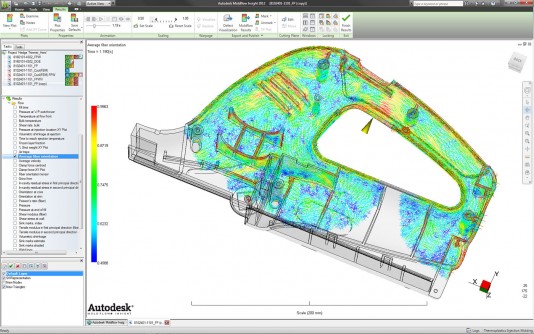The former Autodesk Labs Project Cumulus moves sophisticated injection molding simulation from the desktop to an on-call cloud. Autodesk is more and more looking like a disruptive influence in CAD and CAE with its string of intriguing cloud-based initiatives.
A year-and-a-half after its Autodesk Labs debut, a cloud-based injection molding simulation solution based on Moldflow technology has been released as a product. New Autodesk Moldflow Insight WS is currently available to customers in North America and Japan.
Moldflow Insight WS provides most of the features found in other Autodesk Moldflow products; the difference is the on-demand cloud-based availability. Plastics engineers and specialists can use it to validate and optimize the design of plastic parts and injection molds and study the plastic injection molding process without tying up desktop resources to perform simulations.

The new product provides injection molding simulation tools for validating and optimizing plastic parts, injection molds, and the injection molding process. The software guides designers, mold makers, and engineers through simulation setup and results interpretation to show how changes to wall thickness, gate location, material, and geometry affect manufacturability. Like the desktop versions of Autodesk Moldflow, Moldflow Insight WS offers geometry support ranging from thin-walled parts to thick and solid applications and helps users experiment with “what-if” scenarios before finalizing a design.
Previously available as Project Cumulus, Autodesk Moldflow Insight WS is available in three versions, based on the anticipated hours of usage:
Moldflow Insight WS Standard—Provides 200 hours per year of cloud computing, enough for approximately 150 small simulations;
Moldflow Insight WS Premium—Provides 800 hours per year of cloud computing, enough for approximately 300 medium simulations;
Moldflow Insight WS Ultimate—Provides 2,500 hours per year of cloud computing, enough for approximately 500 large simulations.

To support its increase services in simulation and analysis, Autodesk has started an internal group called The SIM Squad, which will provide support for all Autodesk simulation users.
The disruptive lightness of the Autodesk cloud
I see a pattern emerging, and it is a rather disruptive one for the CAD industry. When Autodesk introduces a new cloud-based technology, I nod my head and think, “yeah, that makes sense; good use of the technology.” When Dassault Systèmes demonstrates a new cloud-based technology, I shake my head and think, “It will be a long time before CAD users want to do THAT with cloud technology.” The other CAD vendors above $500 million in annual revenue are still working out what they want to do with cloud technology.
Autodesk keeps cranking out clouds like a hurricane breaking up over land. Delivering a comprehensive set of cloud-enabled tools for injection molding simulation, Moldflow Insight WS helps users optimize and validate even the most complex geometries without tying up desktop or LAN resources. Providing access to computational power in the cloud eliminates the need for costly, specialized hardware to enable solving multiple scenarios in parallel. It is a win-win scenario, and users are noticing.





